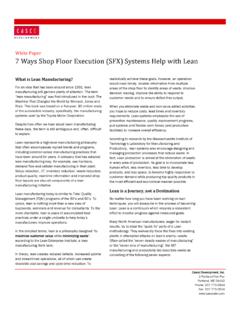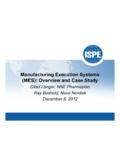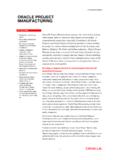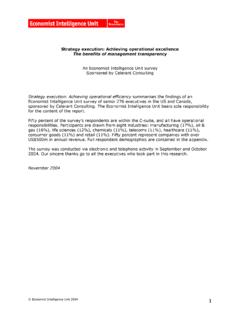Transcription of Lean Manufacturing Assessment - Buker, Inc
1 Buker, Educationand Consulting 800-654-7990email: ManufacturingAssessmentLean Manufacturing Assessment TWELVE ELEMENTS OF lean Manufacturing lean Manufacturing consists of three management areas made up of 12 elements. These areas are Technology Management, People Management and Systems Management. Each area includes four elements of lean Manufacturing . The Technology Management elements are Structured Flow Manufacturing , Small Lot Production, Setup Reduction, and Fitness for Use. The objective of Technology Management is a Responsive Business Environment. This means developing flexibility to respond to changes in individual customer demand, changes in marketplace conditions or to produce to customer orders of one or one thousand.
2 In other words, produce the product when and how the customer wants it. Figure 1: Three Key Management Areas in any Manufacturing Business THREE KEY MANAGEMENT AREAS IN THREE KEY MANAGEMENT AREAS IN ANY Manufacturing BUSINESSANY Manufacturing BUSINESSTECHNOLOGY MANAGEMENTOBJECTIVE: RESPONSIVE PRODUCTION ENVIRONMENTPEOPLE MANAGEMENTOBJECTIVE: CAPABILITY FOR RAPID IMPROVEMENTSYSTEMS MANAGEMENTOBJECTIVE: CAREFUL APPLICATION OF RESOURCES Structured Flow Manufacturing incorporates the concepts of continuous flow Manufacturing . The focus is on flow and throughput to reduce the cycle time through Manufacturing . It also should be noted that many companies have applied the concepts of Structured Flow Manufacturing to the office environment to shorten cycle time in the total business process.
3 Structured Flow Manufacturing typically involves factory rearrangement or grouping technology into Manufacturing cells for organized throughput. Small lot production means producing the product in ever-decreasing lots or batch sizes until the theoretical lot size of one is reached. The ability to produce one at a time provides the opportunity to make every item every day. This in turn provides the flexibility of responding to customer requirements and meeting those requirements which otherwise could be met only through inventory. Setup reduction or quick changeover is the process of minimizing equipment downtime between material changeovers. Setup time could be thought of as the elapsed time from the last good part of the previous job until the first good part of the new job is produced.
4 The overall objective of reducing setup or changeover time is to facilitate small lot production. Fitness for Use was coined by Dr. Juran in defining the principles of quality. Fitness for Use means understanding and meeting the customer s precise needs. The basic principle is that at each step in the business process there is a customer. Not all customers are external to the business; there also are internal customers. Internal customers are the next work center in the Manufacturing process. Another example would be design engineering handing off new products to Manufacturing in which case Manufacturing is the customer of design engineering. Figure 2: Technology Management ORTORTESESPEOPLEPEOPLESYSTEMSSYSTEMS-TOT AL EMPLOYEE INVOLVEMENT-CONTROL THROUGH VISIBILITY-HOUSEKEEPING-TOTAL QUALITY FOCUS-LEVEL LOAD & BALANCED FLOW-PREVENTATIVE MAINTENANCE-SUPPLIER PARTNERSHIPS-PULL SYSTEMSLEANLEANM anufacturingManufacturingTOTAL TOTAL QUALITY QUALITY FOCUSFOCUSCONTINUOUS CONTINUOUS IMPROVMENTIMPROVMENTTECHNOLOGYTECHNOLOGY -STRUCTURED FLOW Manufacturing -SMALL LOT PRODUCTION-SETUP REDUCTION-FITNESS FOR USE The elements of People Management are Total Employee Involvement, Control Through Visibility, Housekeeping, and Total Quality.
5 The objective is Capability for Rapid Improvement. This means improvements transpire in the total business process on an ongoing or continuous basis. Continuous improvement is achieved through the involvement of people at all levels in the organization. Total Employee Involvement is required to achieve the objective of Capability for Rapid Improvement. Only by everyone being involved in the improvement process can a company achieve continuous improvement in its processes. Employee involvement and continuous improvement will be achieved through Small Group Improvement Activities, typically process improvement teams and/or Kaizen events to implement rapid change. Control Through Visibility provides visual status of the production environment.
6 The objectives in Control Through Visibility are to communicate goals, highlight problems and attack waste. Often times Control Through Visibility is looked at as an extension of basic housekeeping, the idea being that as unnecessary items are removed from the work area it becomes much easier to see and thus work on process problems. "5S" Housekeeping or work place organization means a highly organized and efficient work place. In "5S" Sort, Set in Order, Shine, Standardize and Sustain help to create a high performance workplace that eliminates waste of time, motion and effort as everything (materials and tooling) have a place and everything is in its place. Total Quality is fundamental to lean Manufacturing and can be defined as striving to continually reduce process variability and create repeatable Variations in the process increase costs, and must be managed to improve quality.
7 The primary focus is supplier quality, in box quality and out of box quality customer escapes. Figure 3: People Management SH SH TECHNOLOGYTECHNOLOGYPEOPLEPEOPLESYSTEMSS YSTEMS-STRUCTURED FLOW Manufacturing -SMALL LOT PRODUCTION-SETUP REDUCTION-FITNESS FOR USE-TOTAL EMPLOYEE INVOLVEMENT-CONTROL THROUGH VISIBILITY-HOUSEKEEPING-TOTAL QUALITY FOCUS-LEVEL LOAD & BALANCED FLOW-PREVENTATIVE MAINTENANCE-SUPPLIER PARTNERSHIPS-PULL SYSTEMSLEANLEANM anufacturingManufacturingTOTAL TOTAL QUALITY QUALITY FOCUSFOCUSCONTINUOUS CONTINUOUS IMPROVMENTIMPROVMENT-PEOPLEPEOPLE-TOTAL EMPLOYEE INVOLVEMENT-CONTROL THROUGH VISIBILITY-HOUSEKEEPING-TOTAL QUALITY FOCUS The Systems Management elements are Level Load and Balanced Flow, Preventative Maintenance.
8 Supplier Partnerships and Pull Systems. The objective is Careful Application of Resources which means using all company resources wisely. This can be achieved in lean Manufacturing by extending equipment life, eliminating over-production and developing efficient production processes through the use of Pull Systems. Level Load and Balanced Flow means organizing production processes for scheduled throughput. Leveling and balancing become control mechanisms. The objective is to achieve synchronous production through repeatability and predictability in process cycles. Preventative Maintenance in lean Manufacturing means developing reliable tools of production that run flawlessly. Equipment is in a constant state of readiness with the benefits being extended life of equipment, equipment eliminated as a cause of defects, and prevention of major equipment repairs.
9 Supplier Partnerships will be a total management and company commitment to a cooperative relationship with suppliers. This cooperative relationship will focus on achieving lowest total cost by working on non-price areas of the relationship. The cornerstones of the relationship will be long-term commitments, shared goals and frequent fact-based communications utilizing consignment and Kanban material execution. Pull Systems, often referred to as Kanban, are the mechanisms that activate internal production and supplier processes. The objectives of the Pull System are three-fold: (1) keep the time of producing material as close as possible to the time of using material; (2) maintain accurate and rapid feedback on what really is needed in the work area; and (3) provide local control over stocking levels in the area.
10 Figure 4: Systems Management SHORT SHORT CYCLESCYCLESTECHNOLOGYTECHNOLOGYPEOPLEPE OPLE-STRUCTURED FLOW Manufacturing -SMALL LOT PRODUCTION-SETUP REDUCTION-FITNESS FOR USE-TOTAL EMPLOYEE INVOLVEMENT-CONTROL THROUGH VISIBILITY-HOUSEKEEPING-TOTAL QUALITY FOCUSLEANLEANM anufacturingManufacturingTOTOCONTINUOUS CONTINUOUS IMPROVMENTIMPROVMENTSYSTEMSSYSTEMS-LEVEL LOAD & BALANCED FLOW-PREVENTATIVE MAINTENANCE-SUPPLIER PARTNERSHIPS-PULL SYSTEMS Each Manufacturing environment that Buker, Inc. has worked with has all 12 of the lean Manufacturing elements in place. It should be noted that the degree of application of the 12 elements in each company can and may be different. For example, in a traditional job shop manufacturer there could be tremendous application of structured flow Manufacturing for improved throughput, thus leading to cycle time reduction, while another company that is a process manufacturer already may understand the importance of structured flow Manufacturing , but may need to focus on preventative maintenance and setup reduction.






